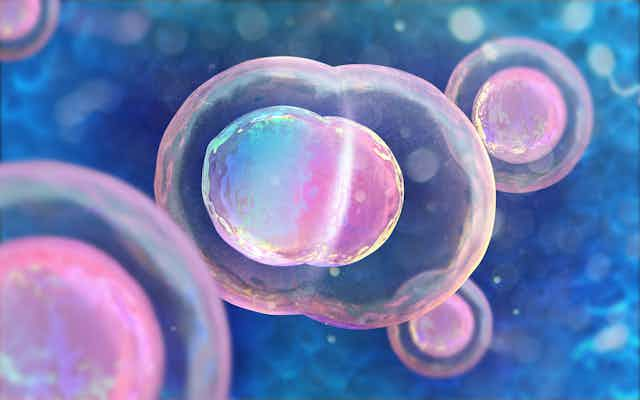Following early reports last week that scientists had edited the DNA of human embryos, American researchers have now published their much anticipated paper in the journal Nature.
The human embryos used in the research were created using eggs collected from healthy women and sperm from a man carrying a DNA error. Thus some of the embryos carried the DNA error, and some were “healthy”.
Led by Hong Ma of Oregon Health and Science University, the researchers then used the gene-editing technology known as CRISPR in the embryos to try to correct the error, which causes catastrophic genetic heart disease in adults.
In more than half of the embryos, the DNA mutation was replaced with “healthy” DNA, and these embryos appeared to grow normally to the blastocyst stage (the point at which they would normally be transferred back into the woman’s uterus during the IVF process - in this study, the blastocysts were destroyed during analysis).
Read more: Editing human embryos with CRISPR is moving ahead – now's the time to work out the ethics
Simply put, CRISPR is like a sat-nav-guided pair of molecular scissors. It is directed to a specific location in the DNA and performs a cut-and-paste function, not unlike word-processing software.
Genetic diseases are a significant cause of healthcare spending and death globally, and many research groups are using CRISPR as a tool to try to combat them.
This latest paper is not the first time human embryos have been genetically modified, and is one of many examples of CRISPR being successfully applied to remove a target gene.
But it is the first time a disease-causing mutation has been repaired in a significant number of healthy human embryos, created specifically for research. And, for me, this advance is both notable and problematic all at once. It creates a leap forward in several key aspects of science. On the other hand, it highlights ethical dilemmas that we regularly grapple with in reproductive health.
Read more: World’s first genetically modified human embryo
Science win: we know more about embryos
From a purely research perspective, this paper is an exciting advance.
CRISPR gives us the ability to edit embryos one gene at a time, to learn about the events that happen in the first five days of life, and to tease apart how the sperm and egg come together to form a ball of cells, which ultimately go on to form a healthy baby.
It may also help us to understand more about infertility, miscarriage and stillbirth, plus many diseases and disorders, by making better and new animal models of disease.
Science win: the right timing improves CRISPR
Building on previous research from other groups, in the new research Ma and colleagues improve the success rates of DNA editing by changing the timing.
By using CRISPR to alter the DNA just as the sperm and egg came together, they improved the frequency at which the editing happened, and also how often it was correct. The issue of timing presented challenges in previous attempts, where mistakes were frequent.
There is still room for improvement though, with small mistakes still incorporated, meaning these embryos would never be suitable to transfer to a patient. We are by no means at the point where this technology is ready for use.
Ethical quandary: editing healthy embryos
Unlike research groups before them – which worked on embryos that were not capable of ever becoming a baby – this study involved the creation of healthy human embryos specifically for research purposes.
Scientific research is sometimes faced with these catch-22 moments where advancement is not likely without facing enormous moral and ethical challenges. Some of science’s greatest breakthroughs have used animal models or questionable experiments on humans.
As detailed in the paper’s research methods, the scientists adhered to strict ethical guidelines, and were monitored closely by committees of individuals including not just scientists and doctors, but also members of the general public.
Research using human embryos is highly regulated, and is different between countries. In Australia, the National Health and Medical Research Council has a strict set of guidelines, meaning that all research performed on human embryos is monitored very closely, and many limitations exist.
Ethical quandary: multiple opinions matter
Science is not as simple as just being able to perform a biological technique successfully in a laboratory setting. Research must proceed only with extreme caution.
Concurrent with advances in benchtop biology, multidisciplinary teams of biologists, IVF specialists, psychologists, bioethicists, social scientists, policy makers and advisers, disability advocates, and most importantly consumers (as well as many others) must work together.
Read more: Human genome editing: We should all have a say
If one day scientists are positioned to perform genome editing safely in humans, this should only happen if society considers it useful, appropriate and desirable.
Ethical quandary: where to from here?
As a biologist, understanding if this technology is safe, and whether a healthy human baby can be born from a genetically modified human embryo seems unanswerable right now.
So many questions remain. When and how will we know that it is time to create a living, breathing human from a modified embryo? Should we take the risk of proceeding with the first full term human pregnancy, not knowing if the technology will have unexpected adverse consequences?
Seeing more experiments being performed in larger animal models (agricultural species like cow and pig) and in non-human primates will be essential. This step should – in my opinion – be a research priority, before more healthy human embryos are used for research purposes.

